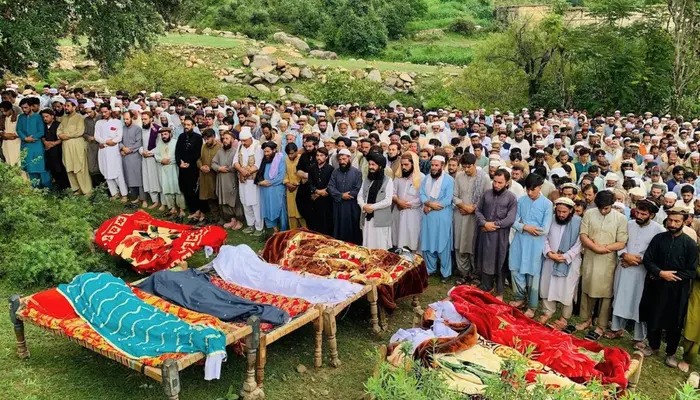
Rescuers in northern Pakistan have recovered dozens of bodies overnight after Pakistan flash floods and landslides ravaged villages, taking the death toll to at least 321 in just two days. Disaster agencies confirmed that hundreds remain missing while emergency teams continue desperate searches for survivors in Khyber Pakhtunkhwa province.
Torrential Rains Trigger Devastation
The floods struck after torrential rains and cloudbursts battered Buner district in northwest Pakistan on Friday. The sudden surge of water washed away dozens of homes, leaving families trapped under mud and debris. According to the provincial Disaster Management Authority, the villages of Pir Baba and Malik Pura suffered the highest casualties.
Deputy Commissioner Kashif Qayyum said rescue workers were struggling to reach remote areas due to blocked roads and continuous rainfall. “We do not know from where the floodwater came, but it came so fast that many could not leave their homes,” said Mohammad Khan, a 53-year-old resident of Pir Baba.
Read more: Babar, Rizwan Still Out of Plans for Tri-Series and Asia Cup
Survivors Mourn as Bodies Arrive
At Buner’s government hospital, Dr Mohammad Tariq confirmed that most victims died before receiving medical treatment. “Many among the dead were children and men, while women were away in the hills collecting firewood and grazing cattle,” he explained.
Families carried the bodies of loved ones wrapped in cloth, while funeral prayers echoed in devastated villages. Survivors sifted through the wreckage of collapsed houses, searching for belongings or any sign of relatives still missing.
Rising Death Toll Across Khyber Pakhtunkhwa
Officials reported that at least 307 of the deaths occurred in Khyber Pakhtunkhwa alone. With rains continuing, authorities fear the toll could rise further as rescuers uncover more bodies from mudslides and collapsed houses.
The National Disaster Management Authority (NDMA) revealed that since June 2, above-average rainfall linked to climate change has triggered floods and mudslides that have killed around 541 people nationwide. Many districts in the mountainous northwest have been designated as disaster-hit areas, including Buner, Bajaur, Swat, Shangla, Mansehra and Battagram.
Climate Change Behind Deadly Rains
Experts say the unusual intensity of rainfall in recent years is tied to climate change. Cloudbursts, once rare, are now more frequent in northern Pakistan and neighboring Indian-administered Kashmir. Scientists warn that warming temperatures are intensifying the monsoon season, causing sudden downpours that overwhelm fragile infrastructure.
In 2022, Pakistan endured its worst monsoon season on record, which killed more than 1,700 people and inflicted damages estimated at $40 billion. This year’s destruction, experts argue, is another stark reminder of the vulnerability of South Asia to climate disasters.
Evacuation Efforts Continue
Since Thursday, authorities said they have evacuated more than 3,500 tourists stranded in flood-hit areas. However, officials expressed frustration that many travelers are still ignoring warnings to avoid the northern valleys despite the risk of further landslides and flash floods.
Rescue teams, supported by military helicopters and boats, continue to ferry survivors to safer areas. Yet thousands remain displaced, living in temporary shelters or with relatives in less-affected regions.
Cross-Border Floods in Kashmir
The devastation has not been confined to Pakistan. In Indian-administered Kashmir, flash floods have also killed dozens and displaced hundreds in recent days. Villages along mountain slopes and riverbanks have been swept away on both sides of the border, highlighting the shared vulnerability of Himalayan communities.
Experts warn that unless stronger infrastructure and early warning systems are developed, such disasters will become more frequent and deadly in the years ahead.
Government Issues Fresh Alerts
Pakistan’s meteorological department has issued new warnings of heavy rainfall in the northwest over the next 24 hours. Authorities have urged residents to take precautionary measures, especially in low-lying and mountainous areas prone to landslides.
Despite alerts, many villagers say they have little choice but to stay. “We cannot leave our land, our animals, and our homes,” said a farmer in Buner. “Where would we go?”
A Nation in Mourning
As the country braces for more rain, communities across Pakistan are mourning the rising death toll. In mosques and open fields, mass funeral prayers are being offered for the victims of the disaster. Volunteers and aid groups have rushed to distribute food, blankets and tents, but survivors say they fear hunger, disease and homelessness in the coming weeks.
The tragedy underscores the recurring vulnerability of Pakistan’s northern regions during the monsoon season. Each year, flash floods destroy homes, farmland, and livelihoods, leaving behind grief and despair.
For now, the focus remains on rescuing survivors and recovering the dead as Pakistan counts yet another heavy toll from its changing climate and fragile infrastructure.
Follow us on Instagram, YouTube, Facebook,, X and TikTok for latest updates




